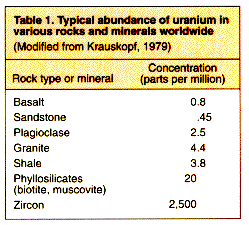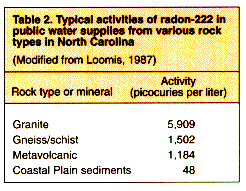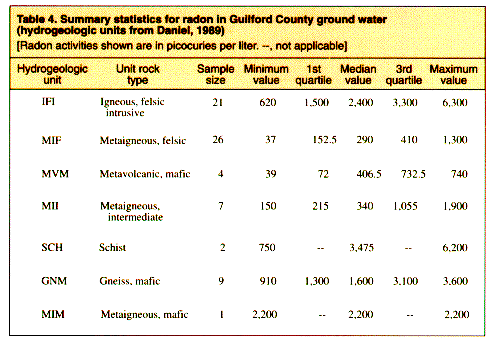Fact Sheet 1997–0147
Approximately 30 percent of the water used in Guilford County, North Carolina, is from ground-water sources (Terziotti and others, 1994). All rural supplies are from ground water; approximately 65,000 residents used ground water for their domestic water supplies in 1990.
The U.S. Geological Survey (USGS), in cooperation with the Guilford County Soil and Water Conservation District and the Guilford County Department of Health, began a study in 1996 of the hydrogeology of Guilford County to update previous work (Mundorff, 1948; Daniel and Sharpless, 1983; Daniel, 1989). As part of this effort and according to methods presented in Koterba and others (1995), dissolved radon samples were collected from 70 wells throughout the county (fig. 1). Because radon in ground water poses a potential health hazard, this report presents results from this sampling effort and the implications that radon may have on ground-water use in Guilford County.
Radon-222 (referred to in this report as radon) is a colorless, odorless, and tasteless gas that was discovered in 1900 by Fredrich Dorn, a chemist who was studying the natural radioactive decay of the element radium. Radon is a heavy gas 7.5 times heavier than air and is the only gas that is naturally radioactive (Heiserman, 1992). Radon and many other radionuclides are associated with rocks containing uranium. Radon is one of the many decay products that result from the radioactive decay of uranium-238 to lead- 206 (Friedlander and Kennedy, 1949). Radioactive alpha or beta particles are emitted at each stage of the decay process. Specifically, radon forms from the decay of radium-226. Radon then emits alpha radiation during its decay to polonium. The relative abundance of uranium in selected rock types is shown in table 1.

Several nationwide studies have shown a relation between geology and radon activity/uranium concentrations (Loomis, 1987; Ogden and others, 1987; Dixon and Lee, 1989; Lindsey and Ator, 1996). Activities of radon in water supplies from various rock types in North Carolina are shown in table 2.

The decay of radon gas produces radioactive particles. Once inhaled, these particles may be retained in the lungs. Further particle decay emits 'bursts' of energy, damaging lung tissue and potentially resulting in lung cancer (U.S Environmental Protection Agency, 1992). Inhalation of air with elevated radon levels presents a much greater health risk than consumption of water with elevated radon (table 3). However, well water may introduce radon gas into air in the home during showering and other household water-use activities. Nationally, radon was reported by Gabler and others (1988) to occur in drinking water at an average value of 240 picocuries per liter (pCi/L) for large water systems and 780 pCi/L in small systems. The U.S. Environmental Protection Agency (USEPA) (1994) reported a median radon activity of 246 pCi/L in public water supplies for about 81,000,000 people in the United States.
Inhalation is thought to be the principal exposure to radon gas. The National Cancer Institute estimates that approximately 10 percent of lung cancer deaths (15,000 deaths each year) in the United States are related to residential radon (National Cancer Institute, 1997). Reports indicate that children are at higher risk for certain cancers from radon (U.S. Environmental Protection Agency, 1992). Smoking and radon combined provide an elevated potential for health problems.
Health risks associated with drinking water containing radon are not well understood. Based on recent information presented in a report to Congress by the USEPA (1994), excess lifetime cancer risks associated with ingestion of water containing various levels of radon and inhalation of indoor air containing radon are shown in table 3. The risks of contracting a radon-related cancer in a 70-year lifetime are compared with risks associated with cigarette smoking and inhaling ambient urban air pollution over a similar 70-year lifetime.

Radon in air and water has been reported as one of the most significant sources of cancer (Gabler and others, 1988). The proposed maximum contaminant level (MCL) for radon in water (300 pCi/L) was withdrawn under the Safe Drinking Water Act Amendments of 1996 (SDWA96) (U.S. Environmental Protection Agency, 1996). The SDWA96 requires the USEPA to determine a new MCL by August 1999. Findings from studies by the National Academy of Sciences (NAS) are planned to be the basis of this new MCL. The NAS will assess the risk of radon in drinking water and the benefits of radon-reduction procedures. Analyses of the radon-reduction benefits and costs are scheduled to be published by the USEPA in February 1999.
Radon activities in the ground water of Guilford County range from 37 to 6,300 pCi/L with a median of 735 pCi/L. The areal distribution of radon activities in water from hydrogeologic units in Guilford County is shown in figure 1. The highest radon activities occurred in younger granites in the northwestern portion of the county (unit IFI) and in the biotite gneiss and schist units in the extreme northwestern part of the county (units GNM and SCH). Lower activities occurred in the older metamorphosed volcanic units in the central and southern part of the county (units MIF, MII, MVM and MIM). Data collected for this study are statistically summarized in table 4. Median activities of radon in each hydrogeologic unit are shown in figure 2. Median radon activities in all hydrogeologic units exceeded 300 pCi/L, the former proposed MCL.

Because radon inhalation is considered to be a primary hazard to human health, it is recommended that homeowners in areas with high radon potential have the ambient air in their homes tested. Methods to seal off radon from homes are presented in several publications (U.S. Environmental Protection Agency, 1992, 1993; U.S. Environmental Protection Agency and Centers for Disease Control, 1992).
Because the risks associated with drinking water containing radon are considered much lower than the risks associated with inhalation of radon (U.S. Environmental Protection Agency, 1994), control methods for radon in drinking water have not received as much attention as control methods for radon in indoor air. The Wisconsin Department of Natural Resources (1996) suggests that homeowners find an alternate water supply if radon levels exceed 5,000 pCi/L; however, this may not be practical or possible. In most cases, radon in drinking water can be reduced effectively by treatment. Aeration systems can be installed at the tap or before the water enters the house. These systems are considered to be the best treatment systems for reducing radon levels in water (Wisconsin Department of Natural Resources, 1996). Granular activated carbon devices also are very effective in lowering radon levels. These devices contain filters which remove radon from water; however, the filters can accumulate high levels of radiation over time, so they must be handled and disposed of properly. Even though the radon activities in water in Guilford County (shown in fig. 2) appear to be high (>300 pCi/L), the risk of contracting cancer from consuming water with the highest radon activity observed during this study (6,200 pCi/L; table 4) is less than the risk from breathing indoor air containing the average radon activity (1.25 pCi/L) for residents throughout the United States (2,100 versus 3,800 chances in one million, as shown in table 3).
Daniel, C.C., III, 1989, Statistical analysis relating well yield to construction practices and siting of wells in the Piedmont and Blue Ridge Provinces of North Carolina: U.S. Geological Survey Water-Supply Paper 2341-A, 27 p.
Daniel, C.C., III, and Sharpless, N.B., 1983, Ground-water supply potential and procedures for well-site selection in the upper Cape Fear River Basin, North Carolina: North Carolina Department of Natural Resources and Community Development, 73 p.
Dixon, K.L., and Lee, R.G., 1989, Radon in ground water supplies: Water Well Journal WWJOA9, v. 43, no. 6, p. 44-49.
Friedlander, Gerhart, and Kennedy, J.W., 1949, Nuclear and radiochemistry: New York, John Wiley & Sons, 468 p.
Gabler, R., and the Editors of Consumer Reports Books, 1988, Is your water safe to drink?: Mount Vernon, N.Y., ConsumerÕs Union, 390 p.
Heiserman, D.L., 1992, Exploring chemical elements and their compounds: Blue Ridge Summit, Pa., TAB Books, 376 p.
Koterba, M.T., Wilde, F.D., and Lapham, W.W., 1995, Ground-water data collection protocols and procedures for the National Water-Quality Assessment Program: Collection and documentation of water-quality samples and related data: U.S. Geological Survey Open-File Report 95-399, 133 p.
Krauskopf, K.B., 1979, Introduction to geochemistry (2d ed.): New York, McGraw-Hill, Inc., 617 p.
Lindsey, B.D., and Ator, S.W., 1996, Radon in ground water of the Susquehanna and Potomac River Basins: U.S. Geological Survey Water-Resources Investigations Report 96-4156, 6 p.
Loomis, D.P., 1987, Radon-222 concen-tration and aquifer lithology in North Carolina: Ground Water Monitoring Review, v. 7, no. 2, p. 33-39.
Mundorff, M.J., 1948, Geology and ground water in the Greensboro area, North Carolina: North Carolina Department of Conservation and Development, Bulletin No. 55, 108 p.
National Cancer Institute, 1997, Meta-analysis of 8 residential radon epidemiological studies: National Cancer Institute General Fact Sheet, 2 p.
Ogden, A.E., Welling, W.B., Funderburg, R.D., and Boschult, L.C., 1987, Preliminary assessment of factors affecting radon levels in Idaho, in Proceedings of the National Water-Well Association conference on radon, radium, and other radioactivity in ground water: Hydro-geologic impact and application to indoor airborne contamination: Somerset, N.J., p. 83-96.
Terziotti, Sylvia, Schrader, T.P., and Treece, M.W., Jr., 1994, Estimated water use, by county, in North Carolina, 1990: U.S. Geological Survey Open-File Report 94-522, 102 p.
U.S. Environmental Protection Agency, 1992, Consumers guide to radon reduction: How to reduce radon levels in your home: EPA 402-K-92-003, 17 p.
_____1993, Home buyer's and seller's guide to radon: EPA 402-R-93-003, 32 p.
_____1994, Report to the United States Congress on radon in drinking water, multimedia risk and cost assessment of radon: EPA 811-R-94-001.
_____1996, Safe Drinking Water Act [Section 1412 (b) (13) (A-D), Radon in drinking water]: Washington, D.C., The Bureau of National Affairs, Inc., p. 71:5608.
U.S. Environmental Protection Agencyand Centers for Disease Control, 1992, A citizen's guide to radon -The guide to protecting yourself and your family from radon (2d ed.): EPA 402-K-92-001, 15 p.
Wisconsin Department of Natural Resources, 1996, Radon in private well water: Wisconsin Department of Natural Resources Publication WS-036.
U.S. Geological Survey, Radon in earth, air, and water:
http://sedwww.cr.usgs.gov:8080/radon/radonhome.html
URL updated June 23 2005: http://energy.cr.usgs.gov/radon/radonhome.html
U.S. Environmental Protection Agency Radon Home Page:
http://www.epa.gov/iedweb00/radon/index.html
Guilford County Department of Public Health
1100 E. Wendover
Ave.
Greensboro, NC 27405
(910) 373-3188
Guilford Soil and Water Conservation District
3309 Burlington
Road
Greensboro, NC 27405
(919) 333-5400
District Chief, U.S. Geological Survey
3916 Sunset Ridge Road
Raleigh, NC 27607-6416
(919) 571-4000
Safe Drinking Water Hotline - U.S. Environmental Protection
Agency, Office of Water and Drinking Water
4601 Resource Center
401 M. Street
S.W.
Washington, D.C. 20460
(800) 426-4791
National Radon Hotline
Box 33435
Washington, D.C. 20035-0435
(800) SOS-RADON [(800) 767-7236]
Spruill, T.B., Williams, J.B., Galeone, D.R., and Harned, D.A., 1997, Radon in ground water in Guilford County, North Carolina: U.S. Geological Survey Fact Sheet FS-147-97, 4 p., https://pubs.usgs.gov/fs/1997/0147.